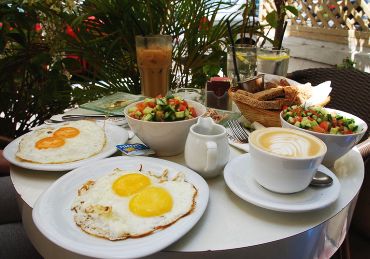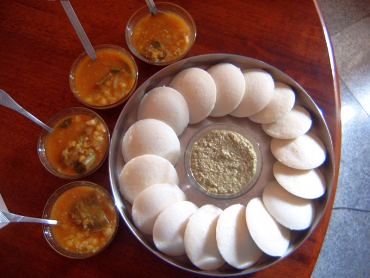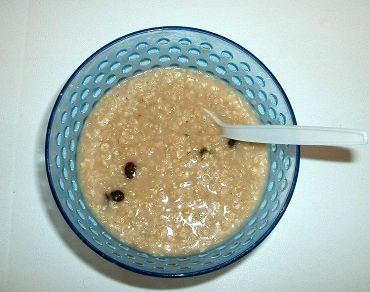
Certified personal trainer and nutritionist Samreedhi Goel gives you the lowdown on healthy and not-so-healthy breakfast choices!
We are constantly being told that breakfast is THE most important meal of the day. You cannot start your day without any fuel -- eating breakfast improves your concentration, alertness and overall performance and keeps you going through the day.
However, all of the above apply only if you have a healthy breakfast that does not overload your system with excess carbohydrates or even the bad kinds of fat.
Making the right choices of food for breakfast is as important as the meal itself! If you start you day on a high-carbohydrate, high-fat meal you are going to end up feeling sluggish and lethargic in the morning itself.
What's more, if the pattern of your breakfast is constantly that of high calorie foods, in the long run it is going to expand your waistline, show up a few more kilos on the weighing scale and negatively affect your lipid profile.
So in the following pages, we're going to give you the lowdown on the worst, fair and best breakfast choices.

Puri Bhaji
Serving: 1 plate (4 puris)
Calories: 450
Fat: 20 gms
Medhu Vada
Serving: 2
Calories: 260
Fat: 15 gms
Batata Vada
Serving: 2
Calories: 320
Fat: 15 gms
Aloo Paratha
Serving: 2
Calories: 580
Fat: 21.5 gms
Potato Toast
Serving: 1
Calories: 368
Fat: 22.9 gms
It doesn't take a genius to figure out why the above rank as the five worst choices.
All are high on fat and very low on nutrition, ie they contain a lot of empty calories. These options are also very high on salt and low on fibre. Unfortuantely, a lot of offices usually serve vadas and samosas as part of the mid-morning snack and most people end up having them as a second breakfast, so imagine the calorie overload early in the morning! Whether you are watching your weight or not, the above are options that should be in the category of 'To be eaten once in a blue moon'!

Veg Upma
Serving: 1 mk
Calories: 180
Fat: 5.5 gms
Potato Poha
Serving: 1 mk
Calories: 185
Fat: 5.4 gms
Idli Sambar
Serving: 2
Calories: 312
Fat: 11 gms
Dhokla
Serving: 5
Calories: 110
Fat: 2.5 gms
Onion Pudla (salty)
Serving: 2
Calories: 350
Fat: 11 gms
As a nutritionist, I am asked nearly everyday -- 'Why can't I include Upma or Poha or any of the above for breakfast?'
While all the above options are not fried and therefore not very high fat choices, they contain a lot of processed/refined carbohydrates and as a result, are low on fibre. Such foods affect and raise your blood glucose levels very quickly and also cause it to drop equally quickly, resulting in low energy and hunger pangs within an hour of eating. Whenever there are high levels of blood glucose in the bloodstream after a meal, some of this excess sugar may be burnt off if you are an active person -- but most of it is converted to fat and stored in the body, causing weight gain!

Oatmeal Porridge
Serving: 30 gms
Calories: 250
Fat: 2 gms
Milk with Bran Flakes
Serving: 30 gms
Calories: 250
Fat: 2 gms
Egg-white Omelette with 2 slices of bread
Serving: 2 whites
Calories: 180
Fat: 5 gms
Daliya (salty) with veggies
Serving: 1 mk
Calories: 150
Fat: 5 gms
Brown bread sandwich with veggies
Serving: 2 slices
Calories: 250
Fat: 5 gms
Oats contain soluble fibre; this fibre is broken down slowly by the body, as a result of which energy is released into the blood stream gradually, keeping you going for the next two-three hours. The porridge can be made more nutrient-rich by adding two walnuts for omega 3 fatty acids & a few (three to four) raisins to add to the taste.
Milk with bran flakes is another ready-to-eat breakfast for people on the go, who don't have much time to cook. You get good quality protein from milk and you get fibre from the cereal which keeps you full, along with several other nutrients which the cereal is fortified with. Add a fruit to this mix and you have a perfect start to the day!
Egg whites can be had boiled, scrambled or as an omelette. If you are watching your weight or your cholesterol, it is best to do away with the yolks and add veggies. However, if you are fit, exercise regularly and keep your meals low-fat, it's okay to add one egg yolk twice weekly for Vitamin B 12. Eggs are a good source of high-quality protein and have a good satiety value.You can have high fibre or multigrain bread to go with it and can even add a fruit later to improve the overall nutrient value.
If you prefer an Indian-style option, daliya with added veggies is a good choice.Wheat cracks or daliya are nothing but broken wheat and contain a high amount of fibre.While it is not a source of high-quality protein, it helps keep you full for a longer time. If you want to improve its nutrient content, add a cup of milk with sugar and eat it as a porridge.
Brown bread/multigrain sandwiches are also a good choice for people who have no time to cook. This high fibre sandwich can be further fortified by adding two or three teaspoons of cottage cheese or just one slice of low-fat cheese.Make sure you add a lot of vegetables -- put in more of coriander chutney and less than a teaspoon of butter if you are watching your weight. Having a glass of milk with the sandwich will make it a more wholesome meal.